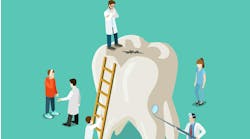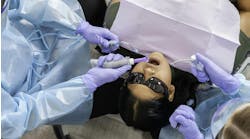By Mary Govoni, CDA, RDA, RDH, MBA
The laboratory in the dental office is an area often overlooked for infection-control protocols, yet there are many opportunities for cross-contamination and potential disease transmission. Ideally, the lab should be a separate location from the instrument sterilization area. But in some facilities space limitations require the lab and sterilization areas to be located in the same room. If this is the case, the lab functions should not be located in the area where instruments are removed from the sterilizer and placed into storage.
The key cross-contamination challenges in the lab are: safe handling of impressions for pouring in the office or sending to the outside lab; disinfection of prostheses that are sent to the outside lab, such as dentures, partials, crowns and bridges; and preventing cross-contamination through the use of polishing (rag) wheels and other devices.
During procedures, it is common for team members to take impressions and other contaminated items to the area while wearing contaminated gloves. Team members should be careful not to touch surfaces or retrieve items from drawers and cupboards while wearing the contaminated gloves. Impressions must be rinsed and disinfected prior to pouring up in the office or prior to sending to the outside laboratory. This can be easily accomplished by either spraying the impression with a surface disinfectant or immersing it in disinfectant, whichever is the most compatible with the type of impression material.
The most fragile material is, of course, alginate, although there are excellent vinyl impression materials available now as substitutes for the less-stable alginates. These products include AlgiNot from Kerr, AlginX from Caulk/DENTSPLY, and Position Penta from 3M ESPE. Although the outside lab will disinfect items as they receive them, prior to handling, it is an OSHA requirement that all items must be disinfected prior to being sent out from the office. If you are not sure what disinfecting solutions or methods to use for prostheses, check with your lab technician about compatibility of products and materials.
Finishing and polishing items in the lab, for use with the laboratory lathe and pumice, should not be reused on multiple patients since they can be contaminated with saliva and possibly blood. Lining the pan with foil or plastic and disposing of the pumice after use will eliminate the potential for cross-contamination. Rag wheels should not be used on multiple patients either. The rag wheel should be discarded after each patient or thoroughly rinsed and placed in the sterilizer. Pure Buff Foam Wheels from Jordco are great alternatives to rag wheels, and are disposable to prevent cross-contamination.
Arbor bands and polishing wheels should be disposed of after use since they cannot be effectively cleaned and sterilized. Burs, such as acrylic trimming burs, should be sterilized between uses since they too may be contaminated with saliva or blood from contact with items that have been in a patient's mouth. Some lab burs have steel shanks and may rust when processed in a steam sterilizer. Dry heat may be more appropriate for these items.
It is also important to note that a safety shield on the laboratory lathe is required by OSHA for protection of the team members who are using the lathe. It also prevents spatter of potential contaminants in the lab. Surface disinfectants should be used on environmental surfaces in the lab whenever there is potential for contamination from touching with contaminated gloves or from contact with contaminated items.
It is always a good idea to review infection prevention protocols to make sure that everyone on the team is on board with appropriate aseptic technique. These key areas in the lab are important ones to review.
Mary Govoni, CDA, RDA, RDH, MBA, is the owner of Mary Govoni & Associates, a consulting company based in Michigan. She is a member of the Organization for Safety, Asepsis and Prevention. She can be contacted at [email protected] or www.marygovoni.com.
Past DE Issues





